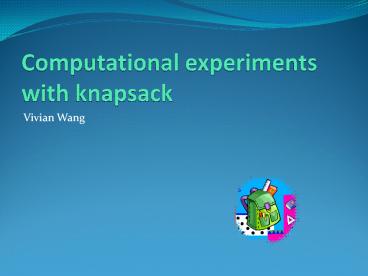Computational experiments with knapsack - PowerPoint PPT Presentation
Title:
Computational experiments with knapsack
Description:
1 | | Single Knapsack Problem . LP formulation: Greedy . Algorithm. Sort jobs by w j /p j and . Take jobs with largest . Weight per time used – PowerPoint PPT presentation
Number of Views:137
Avg rating:3.0/5.0
Title: Computational experiments with knapsack
1
Computational experiments with knapsack
- Vivian Wang
2
1
- Single Knapsack Problem
- LP formulation
Greedy Algorithm
Sort jobs by wj/pj and Take jobs with largest
Weight per time used
3
Comparison with Dynamic programming
jobs Due date Dynamic Programming Greedy
1000 1000 0.0780 0
1000 5000 0.2824 0
5000 1000 0.2808 0
5000 5000 1.4976 0
7000 7000 3.9 0
50000 50000 Out of memory 0.0312
50000 500000 -- 0.0312
5000000 50000 -- 0.0936
Runtime Runtime O(Dn) O(n log n)
Space Space O(Dn) O(n)
As Problem grows larger, greedy algorithm become
increasingly attractive
4
Accuracy of Greedy solution
Number of Jobs in sack Average Accuracy (greedy)
5 8.1
10 1.5
20 0.8
- For large problems, greedy algorithm saves both
time and space as well as provide close to
optimal solution if large number of jobs can be
scheduled - Checking the upper bound for number of jobs that
can be scheduled is O(nlogn) (sort and schedule
longest process time first)
5
Multiple Knapsacks P
- Formulation
Job j scheduled on machine i
6
Problems
- NP - complete
- LP provides a poor approximation
- tries to order by wj/pj and place 1/P of each
job on each machine - IP has Pn number of decision variables very
slow for large problems
7
Possible Solutions
- Schedule one machine at a time
- Greedy approach
- Dynamic programming
- Pro Very quick solution obtained
- Con - hard to guarantee solution quality
8
Test Results
IP IP dp dp Greedy Greedy
Objective Time Objective Time Objective Time
n20, P4 545 65 545 0 545 0
n50, P2 1181 394 1181 0 1135 0
n 50, P 3 223 657 223 0 205 0
9
Evaluating solution quality for larger problems
- A simple upper bound on the solution can be
obtained by - Where b is the number of jobs that can be
scheduled if we consider all machines as one
Machine 1
Machine 2
Machine 3
Machine 1
10
Evaluating solution quality for larger problems
Upper bound Dynamic programming Dynamic programming Greedy Greedy
Error Time Error Time
n500, P5 0.5 0.078 0.7 0
n1000, P10 21476 0.02 0.1560 1.3 0
n20,000, P15 70015 lt0.01 17.39 1.8 0.18
n50,000, P50 331023 0 69.87 0.5 0.86
11
Other Possible approach
- Column Generation
- Effective where there are multiple instances of
the same job - Relatively simple IP implementation
- Good solutions found quickly
- Using bounds exact solution may be found
- Compute upper bound (solving a surrogate relaxed
problem) - Computer lower bound (finds optimal for each
sack) - Branch on each xij update bounds when needed
- Solves n1000, p10 in under 10 seconds
12
References
- MARTELLO, S., AND TOTH, P. Heuristic algorithms
for the multiple knapsack problem. Computing 27
(1981), 93-112. - Pisinger, David (1999) An exact algorithm for
large multiple knapsack problems. European
Journal of Operational Research
13
(No Transcript)

